As this is our second time in Venice and we’re (almost) living like locals, the main attractions are not on our list. Our home exchange is in Castello, which is a working class area of Venice. Our host, Pierleone, is waiting at the vaporetto station, Ospedale, when we arrive from the airport. He takes us in light rain through a maze of streets that I will never remember. I hope Jean Michel will.
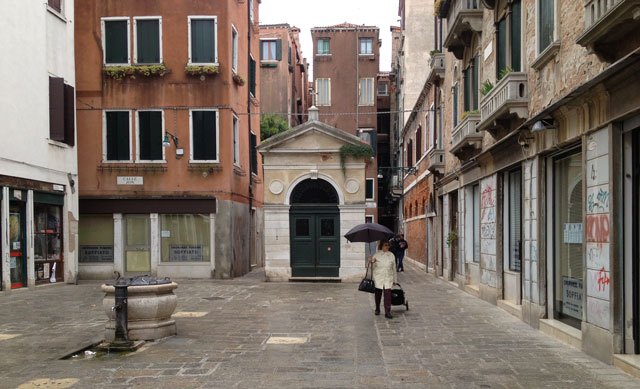
Our first floor flat is on the a corner of two narrow streets. It is small but clean and appears to have everything we need. The windows give directly onto the street and we can see people walking past. Pierleone, who speaks French, has set out a handful of brochures on the table and tells us about several places to visit that are off the beaten track.
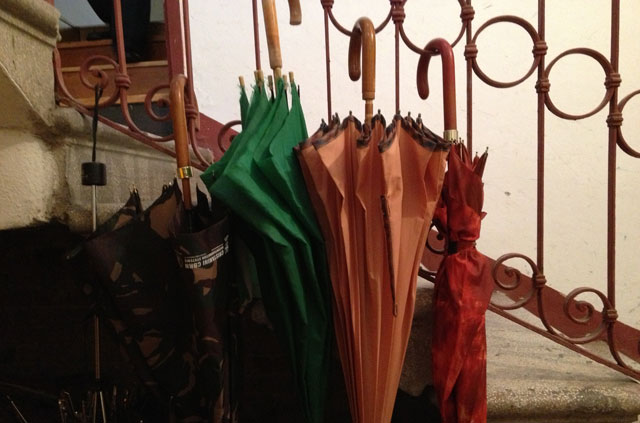
We leave our luggage but don’t unpack, eager to be outside. We set out for nearby Piazza San Marco, taking photos of each little bridge and palazzo on the way, despite the rain. Even if there is no sun, it’s still Venezia la serenissima and our accumulated fatigue seems to melt away.
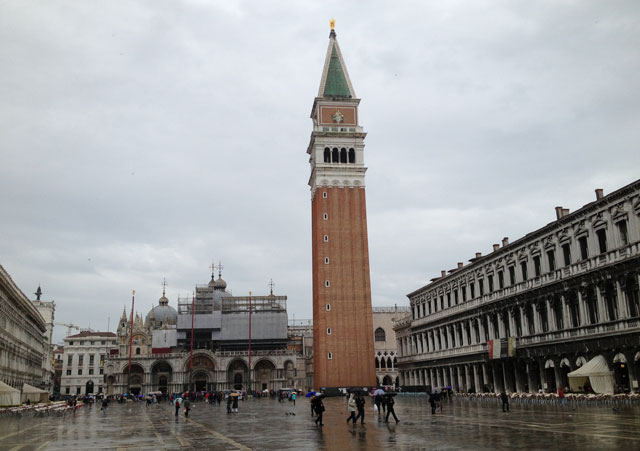
Strange as it may seem for people who know me well, we’re looking for Louis Vuitton near the Corer Museum on the corner of Piazza San Marco at Pierleone’s suggestion but don’t have the name of the street which turns out to be Salizzada San Moise. As we walk in, we’re given a long transparent plastic bag for our dripping umbrella. We head for the staircase, nodding at the shop assistants who all greet us with a friendly buon giorno. At the top floor, we browse through the books on display then enter a darkened room on the right.
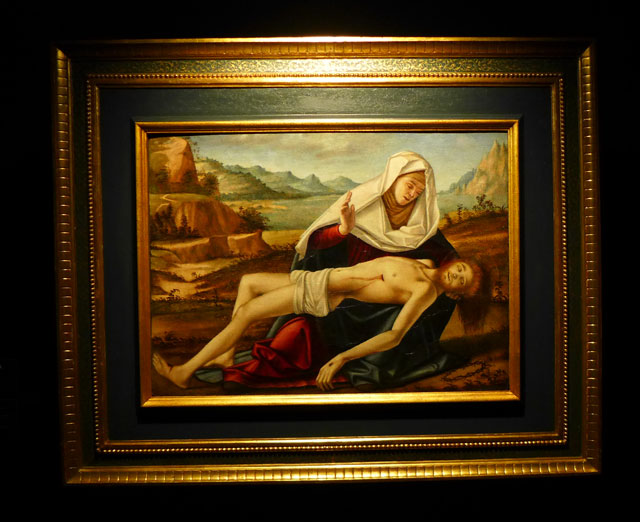
There are two rather stiff-looking paintings by Vittore Carpaccio, a painter of the Venetian school (1465 to 1525), most of whose work remains in Venice, and two projections, one showing two women sitting on the ground on either side of a stone monument suffering some kind of angst, and the other depicting a diver splashing through the water with a sun in the background. We don’t find the artwork particularly interesting but we like the idea of a private exhibition!
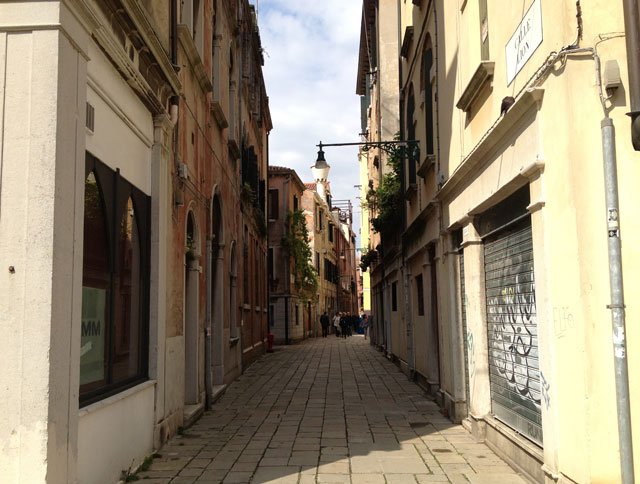
It’s next morning and we don’t feel very refreshed. It turns out there is a very bright street light just outside our bedroom window which only has Venetian blinds (of course!) and we’re used to almost total darkness from wooden shutters in Blois and opaque curtains in Paris.
We send an SMS to Pierleone because we don’t seem to have a single sharp knife and one of our lights isn’t working. He obligingly comes by immediately, fixes the light and asks what sort of knife we want. We explain we want to cut up fruit and vegetables (it’s a fast day) so he brings us back two serrated knives. When we express surprise, he explains that it’s almost impossible to get a smooth-edged knife in Venice. Could this be true?
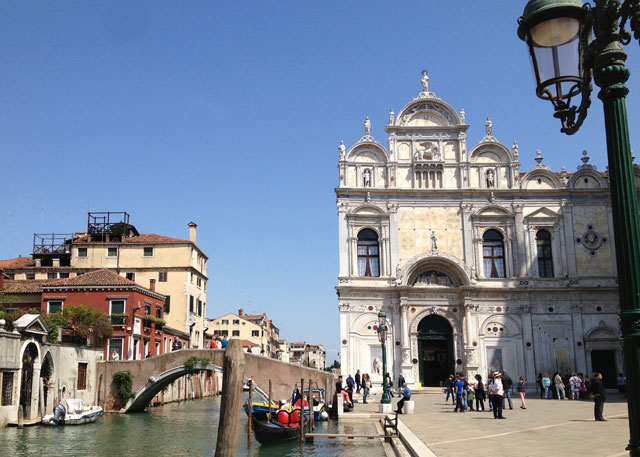
Following another of Pierleone’s suggestions, we go to nearby Campo dei Santi Giovanni e Paolo to visit the Scuola Grande di San Marco, originally a religious charity founded in 1261 and rebuilt in 1487. It is now a public hospital (Ospedale). The ground floor houses a majestic Renaissance hall but Jean Michel is sure there is something else to visit.
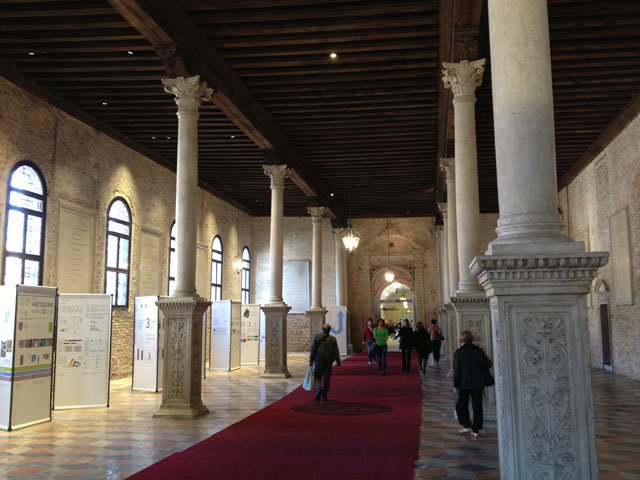
There are no signs to direct us and we are about to leave the building when a man in uniform indicates that we should take a flight of steps to the right. Halfway up we stop in amazement. Before our eyes is a magnificent gilt Renaissance caisson ceiling completed in 1519.
Glass cases around the wall contain primitive-looking antique surgical equipment all beautifully presented as part of the Museum of the History of Medicine.
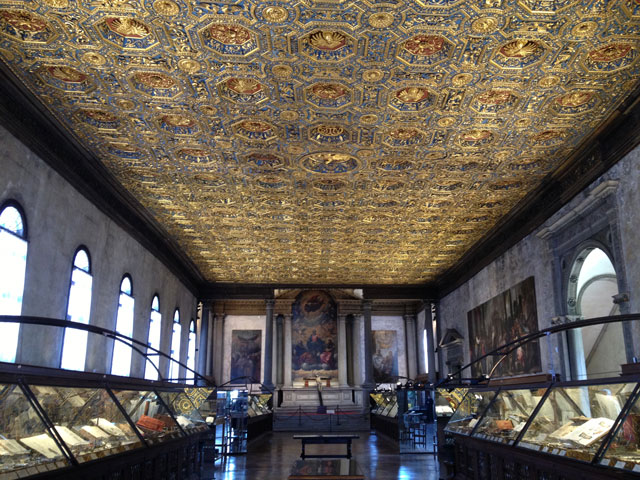
A smaller room contains books and paintings, mostly copies (some the originals are in the Accademia). The one that appeals to me most is by Gentile and Giovanni Bellini depicting Saint Mark preaching in Alexandria, Egypt, the original of which is in Galleria Brera in Milan. I later find further information on Venezia Blog where you can see a lot more (and better) photos.
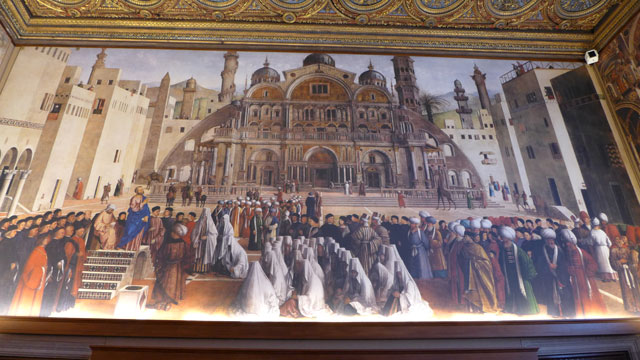
We then have our first espresso for the day in the Campo to rest our weary feet and watch the gondolas and working boats plying the river. We sigh in contentment.
Opening Hours for Grande Scuola di San Marco From Tuesday to Saturday, 9.30 am to 1.00 pm, 2.00 pm to 5.00 pm




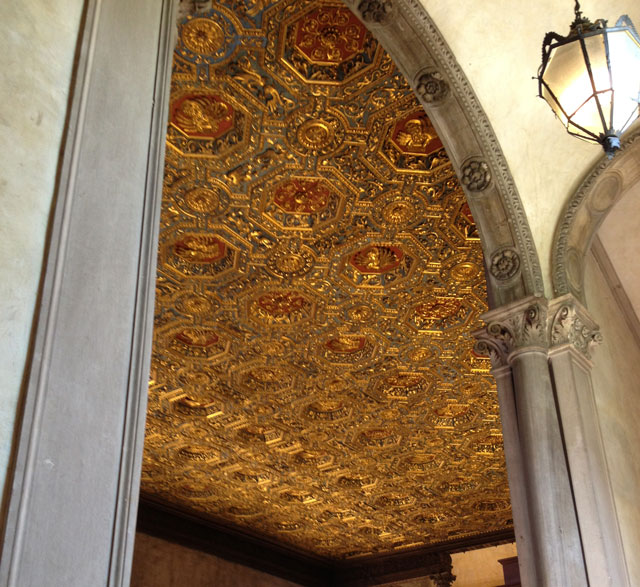
A gorgeous city!
It most certainly is!
I’m loving the photos of Venice in the rain. I’ve been there a few times and it never loses its charm. Have you read any of the Brunetti mysteries of Donna Leon all set in Venice. They’re fabulous and you feel like you are there living in the city and eating with them. Bon seéjour
Hi Jacqueline, glad you’re enjoying them. I think I may have seen one on TV. I didn’t realise there were books. I shall download a couple on my Kindle. I’m reading Seule Venise by Claudie Gallay which isn’t marvellous but it’s set in Venice. Also have Dictionnaire amoureux de Venise by Philippe SOLLERS which is most interesting, even if he sometimes gets on my nerves. I learnt, for example, that Byron fell in the canal when getting into a gondola with a new lady friend!
Rosemary, the mysteries revolve around Guido Brunetti. his academic wife and their children but the real star is Venice. Through the mysteries which always reflect Italian bureaucracy and an unjust system also portray everyday life in Venice, the foods and the people. I suggest starting with the first one because each book “grows” with the Brunetti family. The author Donna Leon is a fascinating woman who has lived in Venice for almost 40 years. Her books, written in English, have been translated and big successes in many countries. However, she refused the rights to Italian publishers because she wants to remain anonymous in Italy and live in peace. There’s even a cookbook that pairs excerpts from the Brunetti mysteries with recipes for the foods discussed in the book!
Thank you Jacqueline. Then I shall start with the first. I did wonder!
YAY! We just did our first trip to Venice a couple of weeks ago. It is such an amazing city – love seeing your pictures!